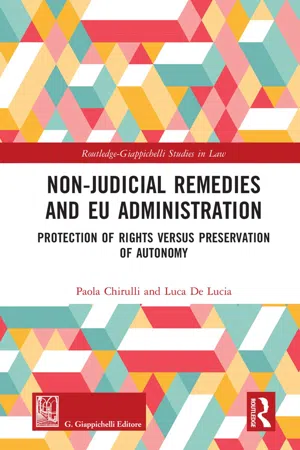
Non-Judicial Remedies and EU Administration
Protection of Rights versus Preservation of Autonomy
- 272 pages
- English
- ePUB (mobile friendly)
- Available on iOS & Android
Non-Judicial Remedies and EU Administration
Protection of Rights versus Preservation of Autonomy
About this book
The increasing number of executive tasks assigned to EU institutions and agencies has resulted in a greater demand for justice that can no longer be satisfied by the courts alone. This has led to the development of a wide range of administrative remedies that have become a central part of the EU administrative justice system. This book examines the important theoretical and practical issues raised by this phenomenon.
The work focuses on five administrative remedies: internal review; administrative appeals to the Commission against decisions of executive and decentralised agencies; independent administrative review of decisions of decentralised agencies; complaints to the EU Ombudsman; and complaints to the EU Data Protection Supervisor. The research rests on the idea that there is a complex, and at times ambivalent, relationship between administrative remedies and the varying degrees of autonomy of EU institutions and bodies, offices and agencies. The work draws on legislation, internal rules of executive bodies, administrative practices and specific case law, data and statistics. This empirical approach helps to unveil the true dynamics present within these procedures and demonstrates that whilst administrative remedies may improve the relationship between individuals and the EU administration, their interplay with administrative autonomy might lead to a risk of fragmentation and incoherence in the EU administrative justice system.
Frequently asked questions
- Essential is ideal for learners and professionals who enjoy exploring a wide range of subjects. Access the Essential Library with 800,000+ trusted titles and best-sellers across business, personal growth, and the humanities. Includes unlimited reading time and Standard Read Aloud voice.
- Complete: Perfect for advanced learners and researchers needing full, unrestricted access. Unlock 1.4M+ books across hundreds of subjects, including academic and specialized titles. The Complete Plan also includes advanced features like Premium Read Aloud and Research Assistant.
Please note we cannot support devices running on iOS 13 and Android 7 or earlier. Learn more about using the app.
Information
IV Administrative review before the EU agencies’ Boards of Appeal
1 Boards of Appeal: types and constitutional basis
Table of contents
- Cover
- Half Title
- Title
- Copyright
- Contents
- Table of cases
- Table of legislation
- Table of abbreviations
- Introduction
- I Administrative remedies and the autonomy of EU administrations
- II Internal review
- III Appeals to the Commission against decisions of EU agencies
- IV Administrative review before the EU agencies’ Boards of Appeal
- V Complaints to the European Ombudsman
- VI Administrative remedies and personal data processing
- VII Accountability, transformative tensions and the need for constitutionalisation
- Index